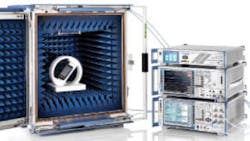Get The Measure of LTE Device Radiated Spurious Emissions-Fast
Radiated emissions can be a problem with some wireless designs, especially when the levels of those emissions are unacceptably high. They can interfere with other wireless devices, or even functionality within the design itself. For that reason, accurate measurements of radiated emissions are critical to ensuring that other electronics systems in the vicinity are not interfered with.
German instrument specialists Rohde & Schwarz (R&S) says that the conventional approach to measuring radiated spurious emissions (RSE) is to filter out the high-level wireless communications signals. While correct, this becomes a very costly and time-consuming process when it comes to the Long-Term-Evolution (LTE) standard, which uses 258 combinations of frequency bandwidths.
R&S is taking a completely new approach to measuring RSE on LTE devices, making it easier for users to measure RSE in the presence of LTE carrier power. The solution is the R&S OSP open switch and control platform equipped with the new R&S OSP-B155 option (see photo). The company says this equipment is the same price as a conventional test setup with notch filter.
Standardization bodies such as the International Telecommunication Union (ITU) or the European Radio and Telecommunications Terminal Equipment (R&TTE) Directive specify tests for measuring RSE on wireless devices. With conventional wireless communications techniques, the high-level radio signal can be filtered out to enable RSE measurements. But LTE defines 43 frequency bands and can transmitat full powerin six bandwidths within each band. Filtering out all LTE signals present in each band and bandwidth involves a separate cabinet to accommodate the 258 filters needed to cover all frequency bandwidth combinations.
The R&S solution requires only two height units (2U) in the control cabinet. The R&S OSP-B155 plug-in module shifts the entire received signal spectrum into the optimum power range to allow full use of the dynamic range of the connected EMI test receiver. The receiver can analyze the entire LTE signal spectrum without requiring a notch filter. A crucial element for accurate measurement using this technique is high receiver sensitivity. Only a high-performance EMI test receiver can detect all the spurious emissions.
The test receiver must also have a high dynamic range to prevent peak levels of the transmitted wireless signals from distorting measurement results. The R&S ESU EMI test receiver offers high sensitivity of typically -155 dBm/Hz, combined with a high dynamic range of 80 dB in the relevant frequency range, making it an ideal choice for this type of measurement.
The R&S OSP-B155 option fits into two slots on the R&S OSP. It is designed to be used with the R&S ESU test receiver and R&S EMC32 EMC measurement software, also from Rohde & Schwarz. In combination with the R&S CMW500 wideband radio communication tester, which provides LTE signaling, the new R&S measurement solution seamlessly integrates also into existing applications and systems.
About the Author
Paul Whytock
Editor-in-Chief
Paul Whytock is European Editor for Microwaves & RF and European Editor-in-Chief for Electronic Design. He reports on the latest news and technology developments in Europe for his US readers while providing his European engineering audience with global news coverage from the electronics sector. Trained originally as a design engineer with Ford Motor Co., Whytock holds an HNC in mechanical, electrical, and production engineering.
